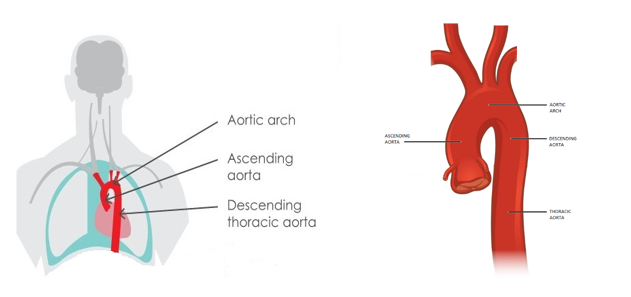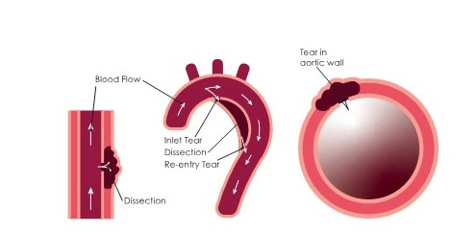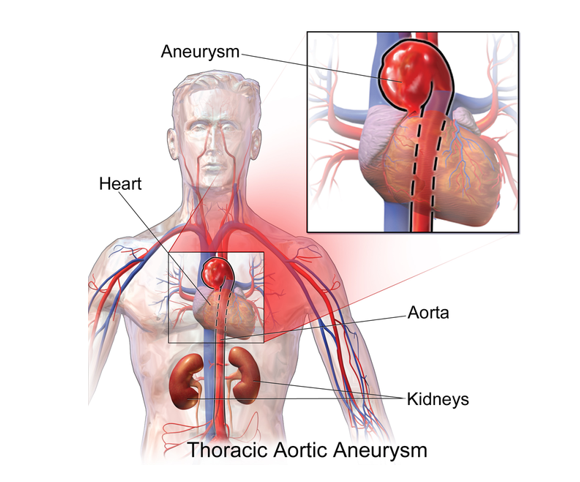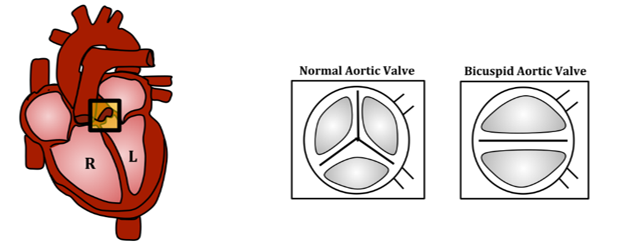- Reference Number: HEY1431/2024
- Departments: Cardiology
- Last Updated: 31 May 2024
What is the aorta?
The aorta is the largest artery in your body. It comes out of your heart and carries oxygen-rich blood to the rest of your body. A normal aorta is usually less than 4 cm wide where it exits the heart.

What is a thoracic aortic aneurysm?
A thoracic aortic aneurysm is a condition where the thoracic aorta, the main artery in your chest, enlarges due to a weakness in the wall of the artery. This weak spot causes the artery to balloon outwards under the pressure of the blood flowing through it. This condition can vary in severity over time. It may be inherited and/or influenced by lifestyle factors such as smoking and high blood pressure.
Why is diagnosis important?
Over time, the weakened area may expand further and eventually rupture, leading to a life-threatening condition known as “aortic dissection.” – a tear in the aorta. Blood can then leak through the torn layers, worsening the tear and causing severe pain, while reducing the flow of oxygenated blood to the whole body. The dissected aortic wall is at high risk of bursting, leading to life-threatening internal bleeding that usually needs emergency surgery to fix.

Diagnosis of a thoracic aortic aneurysm is vital, especially if there is a family history of the condition, so that we can aim to prevent aortic dissection. Screening is particularly important, as thoracic aortic aneurysms are often silent diseases, meaning that you may not have noticeable symptoms until serious or even fatal complications arise.
Early detection and treatment of an aneurysm through screening can significantly improve long-term outcomes and reduce the risk of complications.
Important information for first-degree relatives
If you are a first-degree relative (parent, sibling, or child) of someone with a thoracic aortic aneurysm, it is vital to have regular screening, because you are at increased risk of developing an aneurysm during your lifetime. When a patient is diagnosed with an aortic aneurysm, there is around 1 in 5 chance that a close family member may also have an aortic aneurysm.
Screening involves having regular scans of your aorta. How often you have a scan will depend on your age and the size of your aorta. Early detection of an aneurysm through regular screening can significantly improve outcomes and reduce the risk of serious complications such as aortic dissection.
We write a screening letter to all first-degree relatives of patients with thoracic aortic aneurysm. These letters should be given to your GP, who will then refer you to local cardiology services to begin the screening process. Following the advice in the screening letter is essential for your future health and well-being. If you would like to know more about screening, visit the THINK AORTA, THINK FAMILY website www.thinkaorta.net/family.
Understanding thoracic aortic aneurysm

What causes a thoracic aortic aneurysm?
Factors that may cause a thoracic aortic aneurysm include:
- Genetic disorders
- Hardening of the arteries (atherosclerosis)
- High blood pressure
- Infection (this is rare)
- Inflammation of the arteries (vasculitis)
- Smoking (leading to injury of the wall of the aorta)
- Traumatic injury
- Weakness of the artery wall from smoking or high blood pressure
- Family history of aortic aneurysms
Signs and symptoms
Thoracic aortic aneurysms often have no symptoms, but they may cause pain in the jaw, neck, chest, or back. Rarely, an aneurysm may cause a persistent cough, hoarseness, or difficulty breathing.
Various tests may be ordered to diagnose a thoracic aortic aneurysm
- Echocardiogram (heart ultrasound): Uses high-frequency sound waves to take moving pictures of your heart (the same technology as is used to view unborn babies when women are pregnant).
- Computerized tomography scan (CT or CAT scan): Uses X-rays and a contrast dye injected into your vein to take pictures of parts of your body, such as your aorta, that are not visible on ordinary X-rays.
- Cardiac magnetic resonance imaging (MRI): Uses a magnetic field and radio waves to take detailed pictures of your heart and aorta, while also assessing how well your heart works.
Treatment options
Treatment depends on many factors, such as the size and location of the aneurysm, your age and underlying health. It may include regular monitoring, medication, surgery when the aneurysm gets to a certain size, or “endovascular” treatment – a less invasive repair where a “stent” is placed inside the aorta to repair the aneurysm.
Regular monitoring, good blood pressure control, and lifestyle modifications are essential to manage the condition effectively.
Lifestyle recommendations
- The most important things you can do is to keep your blood pressure within a healthy range, typically around 120/80, with guidance from your doctor.
- Stop smoking.
- Maintain a healthy weight for your body.
- Follow a heart-healthy diet low in sodium, fat, and cholesterol.
- Engage in mild to moderate physical activity regularly, such as walking, biking, swimming, dancing, light jogging, and stair climbing.
- Attend regular appointments with your doctor to monitor your aneurysm and overall health.
- Encourage your first-degree relatives (parents, siblings, and adult children) to get screening for their risk of thoracic aortic aneurysm.
- Address mental health concerns promptly to prevent elevated blood pressure.
- Get the flu vaccine and avoid constipation.
- Do not participate in intense, competitive, or contact sports.
- Avoid heavy lifting beyond 30 pounds and risky activities like getting tattoos or piercings.
- Take anbitiotics before dental or invasive procedures if you’ve had aortic aneurysm surgery.
- Avoid risky activities like shovelling snow or using stimulants such as ephedra, cocaine, or amphetamines.
- Avoid taking fluoroquinolone antibiotics such as ciprofloxacin and levofloxacin. If prescribed these antibiotics, consult your provider for an alternative medication.
Conditions associated with an increased risk of thoracic aortic aneurysm
Bicuspid Aortic Valve (BAV)

- A bicuspid aortic valve is a congenital heart defect where the aortic valve, which regulates blood flow from the heart into the aorta, has two flaps (leaflets) instead of the typical three.
How common is it?
- Bicuspid aortic valve is a common congenital heart defect which affects 1–2% of the population.
- It is more prevalent in males than females.
What happens to patients with bicuspid aortic valve?
- Patients with a bicuspid aortic valve often experience premature degeneration of their valve, which can result in narrowing or leaking of the valve.
- There is also an increased risk of developing a thoracic aortic aneurysm.
- Both conditions require monitoring and, in some cases, intervention to prevent complications.
Connective tissue disease
- Diseases, such as Marfan, Loeys-Dietz, Ehlers-Danlos syndromes, and other conditions caused by a faulty gene, affect the strength and integrity of your connective tissues, including those in the aorta. The faulty gene can be passed from parent to child, or it can happen out of the blue (sporadically), so there is no one else in the family with the condition.
- If we suspect a patient has an inherited aortic disease, we will advise them to have a blood test that can identify the defective genes.
- These genetic conditions increase the likelihood of developing thoracic aortic aneurysms, because they weaken the aortic wall.
- Connective tissue diseases cause abnormalities in collagen and elastic fibres in your body, which can lead to enlargement of the aorta over time, increasing the risk of rupture or dissection.
Further information and support
- Obtain information from reputable sources, such as the British Heart Foundation or relevant patient support organizations.
- The THINK AORTA, THINK FAMILY campaign: www.thinkaorta.net/family
- Aortic Dissection: The Patient Guide, specifically pages 83-87: www.tinyurl.com/ADPtGuide
- www.bhf.org.uk/informationsupport/conditions/thoracic-aortic-aneurysm
Picture credits:
- Aortic Dissection Awareness UK & Ireland (www.aorticdissectionawareness.org)
- OpenStax College (https://commons.wikimedia.org/w/index.php?curid=147344255)
- Aortic Dissection Awareness UK & Ireland (aorticdissectionawareness.org)
- Creative CommonsAttribution-Share Alike 4.0 International
- Creative CommonsAttribution-Share Alike 4.0 International

